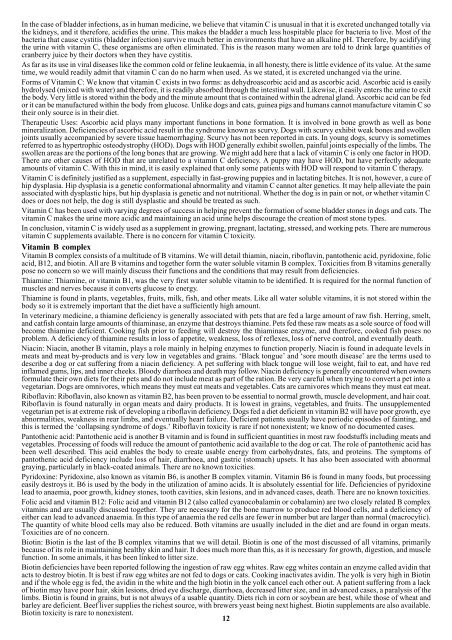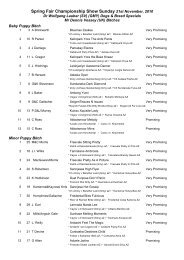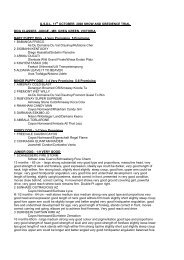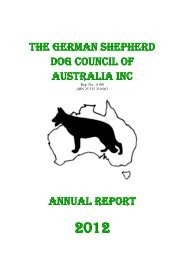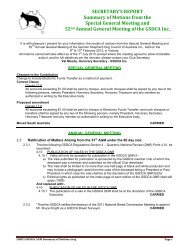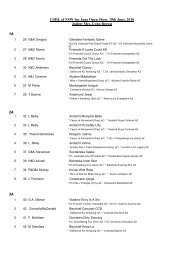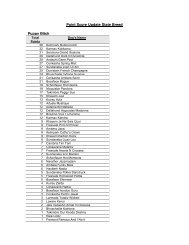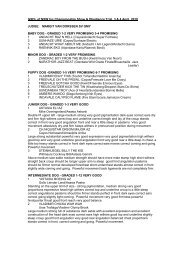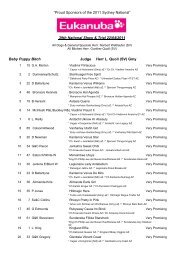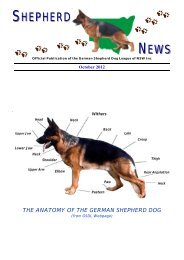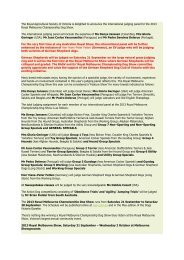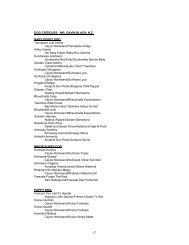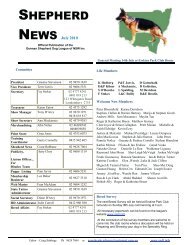Shepherd News 2 - German Shepherd Dog League NSW Inc.
Shepherd News 2 - German Shepherd Dog League NSW Inc.
Shepherd News 2 - German Shepherd Dog League NSW Inc.
You also want an ePaper? Increase the reach of your titles
YUMPU automatically turns print PDFs into web optimized ePapers that Google loves.
In the case of bladder infections, as in human medicine, we believe that vitamin C is unusual in that it is excreted unchanged totally via<br />
the kidneys, and it therefore, acidifies the urine. This makes the bladder a much less hospitable place for bacteria to live. Most of the<br />
bacteria that cause cystitis (bladder infection) survive much better in environments that have an alkaline pH. Therefore, by acidifying<br />
the urine with vitamin C, these organisms are often eliminated. This is the reason many women are told to drink large quantities of<br />
cranberry juice by their doctors when they have cystitis.<br />
As far as its use in viral diseases like the common cold or feline leukaemia, in all honesty, there is little evidence of its value. At the same<br />
time, we would readily admit that vitamin C can do no harm when used. As we stated, it is excreted unchanged via the urine.<br />
Forms of Vitamin C: We know that vitamin C exists in two forms: as dehydroascorbic acid and as ascorbic acid. Ascorbic acid is easily<br />
hydrolysed (mixed with water) and therefore, it is readily absorbed through the intestinal wall. Likewise, it easily enters the urine to exit<br />
the body. Very little is stored within the body and the minute amount that is contained within the adrenal gland. Ascorbic acid can be fed<br />
or it can be manufactured within the body from glucose. Unlike dogs and cats, guinea pigs and humans cannot manufacture vitamin C so<br />
their only source is in their diet.<br />
Therapeutic Uses: Ascorbic acid plays many important functions in bone formation. It is involved in bone growth as well as bone<br />
mineralization. Deficiencies of ascorbic acid result in the syndrome known as scurvy. <strong>Dog</strong>s with scurvy exhibit weak bones and swollen<br />
joints usually accompanied by severe tissue haemorrhaging. Scurvy has not been reported in cats. In young dogs, scurvy is sometimes<br />
referred to as hypertrophic osteodystrophy (HOD). <strong>Dog</strong>s with HOD generally exhibit swollen, painful joints especially of the limbs. The<br />
swollen areas are the portions of the long bones that are growing. We might add here that a lack of vitamin C is only one factor in HOD.<br />
There are other causes of HOD that are unrelated to a vitamin C deficiency. A puppy may have HOD, but have perfectly adequate<br />
amounts of vitamin C. With this in mind, it is easily explained that only some patients with HOD will respond to vitamin C therapy.<br />
Vitamin C is definitely justified as a supplement, especially in fast-growing puppies and in lactating bitches. It is not, however, a cure of<br />
hip dysplasia. Hip dysplasia is a genetic conformational abnormality and vitamin C cannot alter genetics. It may help alleviate the pain<br />
associated with dysplastic hips, but hip dysplasia is genetic and not nutritional. Whether the dog is in pain or not, or whether vitamin C<br />
does or does not help, the dog is still dysplastic and should be treated as such.<br />
Vitamin C has been used with varying degrees of success in helping prevent the formation of some bladder stones in dogs and cats. The<br />
vitamin C makes the urine more acidic and maintaining an acid urine helps discourage the creation of most stone types.<br />
In conclusion, vitamin C is widely used as a supplement in growing, pregnant, lactating, stressed, and working pets. There are numerous<br />
vitamin C supplements available. There is no concern for vitamin C toxicity.<br />
Vitamin B complex<br />
Vitamin B complex consists of a multitude of B vitamins. We will detail thiamin, niacin, riboflavin, pantothenic acid, pyridoxine, folic<br />
acid, B12, and biotin. All are B vitamins and together form the water soluble vitamin B complex. Toxicities from B vitamins generally<br />
pose no concern so we will mainly discuss their functions and the conditions that may result from deficiencies.<br />
Thiamine: Thiamine, or vitamin B1, was the very first water soluble vitamin to be identified. It is required for the normal function of<br />
muscles and nerves because it converts glucose to energy.<br />
Thiamine is found in plants, vegetables, fruits, milk, fish, and other meats. Like all water soluble vitamins, it is not stored within the<br />
body so it is extremely important that the diet have a sufficiently high amount.<br />
In veterinary medicine, a thiamine deficiency is generally associated with pets that are fed a large amount of raw fish. Herring, smelt,<br />
and catfish contain large amounts of thiaminase, an enzyme that destroys thiamine. Pets fed these raw meats as a sole source of food will<br />
become thiamine deficient. Cooking fish prior to feeding will destroy the thiaminase enzyme, and therefore, cooked fish poses no<br />
problem. A deficiency of thiamine results in loss of appetite, weakness, loss of reflexes, loss of nerve control, and eventually death.<br />
Niacin: Niacin, another B vitamin, plays a role mainly in helping enzymes to function properly. Niacin is found in adequate levels in<br />
meats and meat by-products and is very low in vegetables and grains. ‘Black tongue’ and ‘sore mouth disease’ are the terms used to<br />
describe a dog or cat suffering from a niacin deficiency. A pet suffering with black tongue will lose weight, fail to eat, and have red<br />
inflamed gums, lips, and inner cheeks. Bloody diarrhoea and death may follow. Niacin deficiency is generally encountered when owners<br />
formulate their own diets for their pets and do not include meat as part of the ration. Be very careful when trying to convert a pet into a<br />
vegetarian. <strong>Dog</strong>s are omnivores, which means they must eat meats and vegetables. Cats are carnivores which means they must eat meat.<br />
Riboflavin: Riboflavin, also known as vitamin B2, has been proven to be essential to normal growth, muscle development, and hair coat.<br />
Riboflavin is found naturally in organ meats and dairy products. It is lowest in grains, vegetables, and fruits. The unsupplemented<br />
vegetarian pet is at extreme risk of developing a riboflavin deficiency. <strong>Dog</strong>s fed a diet deficient in vitamin B2 will have poor growth, eye<br />
abnormalities, weakness in rear limbs, and eventually heart failure. Deficient patients usually have periodic episodes of fainting, and<br />
this is termed the ‘collapsing syndrome of dogs.’ Riboflavin toxicity is rare if not nonexistent; we know of no documented cases.<br />
Pantothenic acid: Pantothenic acid is another B vitamin and is found in sufficient quantities in most raw foodstuffs including meats and<br />
vegetables. Processing of foods will reduce the amount of pantothenic acid available to the dog or cat. The role of pantothenic acid has<br />
been well described. This acid enables the body to create usable energy from carbohydrates, fats, and proteins. The symptoms of<br />
pantothenic acid deficiency include loss of hair, diarrhoea, and gastric (stomach) upsets. It has also been associated with abnormal<br />
graying, particularly in black-coated animals. There are no known toxicities.<br />
Pyridoxine: Pyridoxine, also known as vitamin B6, is another B complex vitamin. Vitamin B6 is found in many foods, but processing<br />
easily destroys it. B6 is used by the body in the utilization of amino acids. It is absolutely essential for life. Deficiencies of pyridoxine<br />
lead to anaemia, poor growth, kidney stones, tooth cavities, skin lesions, and in advanced cases, death. There are no known toxicities.<br />
Folic acid and vitamin B12: Folic acid and vitamin B12 (also called cyanocobalamin or cobalamin) are two closely related B complex<br />
vitamins and are usually discussed together. They are necessary for the bone marrow to produce red blood cells, and a deficiency of<br />
either can lead to advanced anaemia. In this type of anaemia the red cells are fewer in number but are larger than normal (macrocytic).<br />
The quantity of white blood cells may also be reduced. Both vitamins are usually included in the diet and are found in organ meats.<br />
Toxicities are of no concern.<br />
Biotin: Biotin is the last of the B complex vitamins that we will detail. Biotin is one of the most discussed of all vitamins, primarily<br />
because of its role in maintaining healthy skin and hair. It does much more than this, as it is necessary for growth, digestion, and muscle<br />
function. In some animals, it has been linked to litter size.<br />
Biotin deficiencies have been reported following the ingestion of raw egg whites. Raw egg whites contain an enzyme called avidin that<br />
acts to destroy biotin. It is best if raw egg whites are not fed to dogs or cats. Cooking inactivates avidin. The yolk is very high in Biotin<br />
and if the whole egg is fed, the avidin in the white and the high biotin in the yolk cancel each other out. A patient suffering from a lack<br />
of biotin may have poor hair, skin lesions, dried eye discharge, diarrhoea, decreased litter size, and in advanced cases, a paralysis of the<br />
limbs. Biotin is found in grains, but is not always of a usable quantity. Diets rich in corn or soybean are best, while those of wheat and<br />
barley are deficient. Beef liver supplies the richest source, with brewers yeast being next highest. Biotin supplements are also available.<br />
Biotin toxicity is rare to nonexistent.<br />
12


